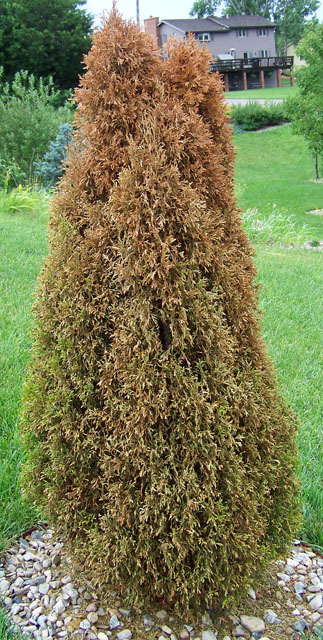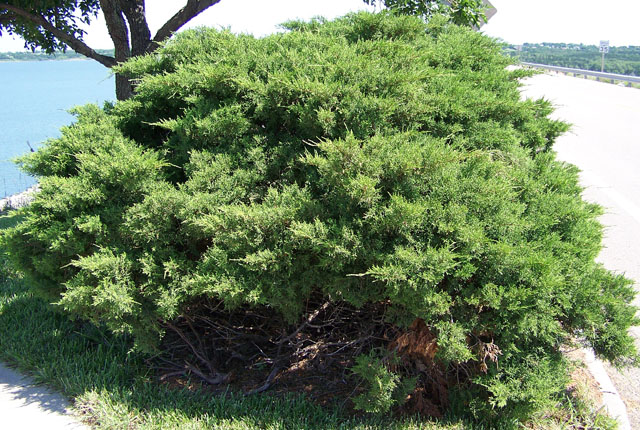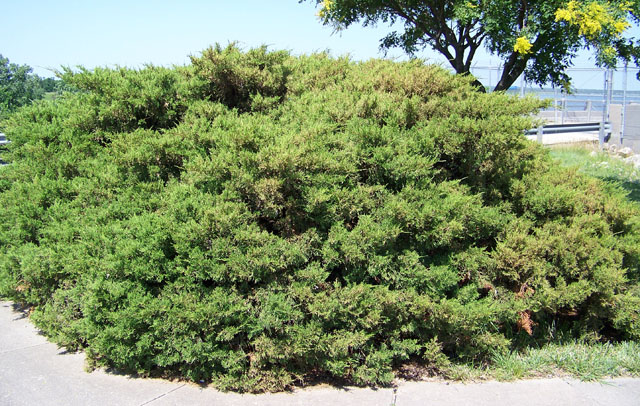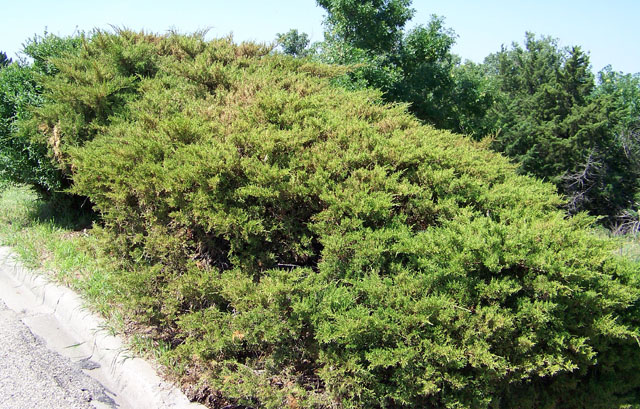

Figure 1 - Mature bagworm bags Figure 2 - damage
Gardening with Chuck©
Bagworms
Bagworms, Thyridopteryx ephemeraeformis (Haworth), are small inconspicuous moths. The small larvae hatch in late May and early June from eggs laid the previous fall. The small larvae will feed on over 200 species of plants, but are of biggest concern on evergreens like juniper/cedar, arborvitae and spruce. These plants can not easily regenerate new foliage to replace that consumed by the bagworms. If left unchecked, they can kill even large trees and shrubs. Shortly after hatching and the start of feeding, the larvae construct a small bag of silken threads around themselves which they decorate with pieces of foliage from the host plant.
Late in the season the mature bags can be 1.5 to 2 inches in length and easy to see (Figure 1). But by then the damage is done and treatment is difficult, even ineffective. By late June and early July, the small bagworms are eating voraciously and causing a lot of damage (Figure 2). But the bagworm bags are small, 3/8 to 1/2 inch in length (Figure 3 & 4).


Figure 1 - Mature bagworm bags
Figure 2 - damage


Figure 3 - arrows point to small bagworms
Figure 4 - bagworm bag close up, 1/8 inch tick marks
In early June, it is often far easier to look for evidence of damage rather than the bagworms themselves. Color is a good indicator of problems. For example, junipers are normally a nice dark green. If all of a sudden they are going an off green or yellowish green color, then that isn't a good sign (Figures 5, 6 & 7).


Figure 5 - Normal, healthy juniper
Figure 6 - Notice discoloration on right hand side of bush

Figure 7 - Notice overall pale yellowish green foliage indicating
heavy bagworm infestation
If nothing is done with the above infested shrubs, they will be heavily damaged and could be dead within another year. By early to mid August, bagworms are usually through feeding. They then form a pupa inside the bag and turn into adults. The female moth is flightless. She will attract males with pheromones, they will mate, and then she will fill up her bag with eggs. One bag can hold as many as 1,000 eggs.
Control
Once a plant is infested, it will probably be infested again unless control
options are used. The normal recommendation, in northeast and north
central Kansas, is to wait until about the 10th of June and apply your first
control application, wait two weeks and apply a second control application.
Biological controls containing Bacillus thuringiensis (Bt) can be very
effective, but they need to be started right at the time of hatching in mid to
late May. As this product works slowly it needs to be applied regularly in
a good thorough drenching through early July.
If it is late June or into July before you discover your bagworm infestation, then a more traditional insecticidal treatment will probably be needed. There are many products that are labeled for bagworm control, in fact most lawn and garden insecticides will include bagworms on their label. What product (active ingredient) you use is far less important than how you apply it. However, the insecticide Spinosad has probably shown the best control of larger bagworms. Since bagworms can be found throughout the dense foliage of an evergreen, a very thorough soaking is critical. High pressure and/or high volume is the best approach. Hose end sprayers are a good way to apply a lot of material to ensure a good thorough soaking (to the point of drip). You can use hose end sprayers that you fill with insecticidal concentrate, or you can use some of the newer products that have a built in hose end sprayer. The advantage of the newer products that come with their own hose end sprayer is that you don't have to worry about how much you mix up as it automatically meters the product as you spray.
If you do not find the infestation until August or even later, there is no need for any kind of chemical treatment. During the fall and winter season it would be a good idea to try to remove as many of the bagworm bags as you can find as they could very well be holding eggs that will hatch the following spring. Even if you remove all the bags you can find, it would be a good idea to treat at the proper time as it is easy to overlook a bag or two that could hold hundreds of eggs.
Fortunately, if an infestation is caught in time, (like all the damage photos above) the infested plant can often recover from the damage in one or two growing seasons, or less. If nothing is done though, the plant will probably be dead after just a few seasons of infestation.
Text and all photos copyrighted by Chuck Otte.
June 2018